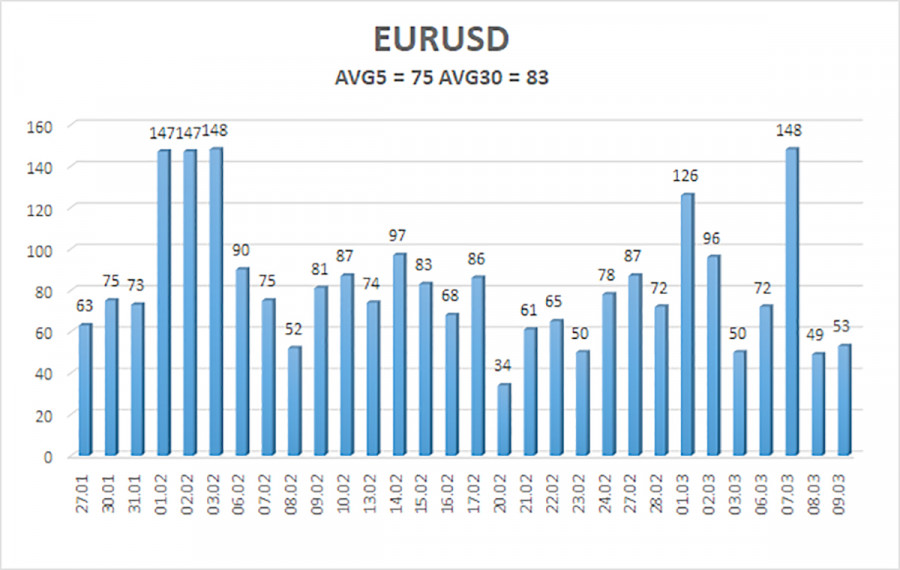

On Wednesday and Thursday, the EUR/USD currency pair was trading much more calmly. The initial impact of Powell's speech quickly subsided, and it is now uncertain what will happen next. On the one hand, the pair has formed a consolidation below the moving average line, which offers great prospects for further decline. Yet, the pair has only surpassed the moving average five times in the past week, so further consolidation below the moving average line is meaningless. Hence, all we can say at this point is that the market may go downward, but in reality, a lot depends on the American statistics that will be announced today. More on it is covered below. Powell's second address to the US Congress contained no new information, as was to be expected. We are taken aback by how the market reacted to the Fed chairman's statement on Tuesday because every argument made was foreseeable. We've stated time and time again that the Fed rate needs to be increased to at least 6% and that any discussion of "the regulator's reaction to reports" or anything similar is nothing more than "a good mine with a poor game." Hence, we were not surprised by Powell's statement regarding the need to speed up the pace of monetary policy tightening once more. The Fed made it clear from the start that it wanted to raise the rate to 2%. And not in the next 5–10 years, but as soon as possible. The topic would be very different if the American economy was on the verge of recession. Nevertheless, very reliable macroeconomic data are being released every month, giving the Federal Reserve every opportunity to tighten monetary policy as required. Following Powell's remarks, the dollar increased as expected, and we think that it will do so going forward.
On the 24-hour TF, the pair continued to gain ground beneath both the Ichimoku cloud and the 38.2% Fibonacci line. As a result, the likelihood of a future decline in the quotes has grown, and we have another sell signal. If today's US reports are successful, the pair might decline another 100 points.
Non-farm and unemployment in the US won't change market sentiment.
We think the debate over raising the rate by 0.5% in March is nearly settled. Jerome Powell rarely makes unsupported claims or assertions that lack substance. If he indicated that there is a chance that the rate of growth will accelerate, the regulator would be preparing for this. Powell's attempt to "step back" in his address on Wednesday was futile, and nobody believed him. The likelihood of a 0.5% rate increase at this point is already more than 50%. Furthermore, this market belief won't be altered by today's reports (in our opinion). Let's analyze it. Will the Fed still go forward with its intentions to raise the rate by 0.5% even if today's non-farm data is weak and unemployment increases? No, we believe. Thus, it's important to consider the entire dynamics and trend rather than just one particular report. Nonfarms consistently perform at a high level. Unlike other experts, we have consistently asserted that adding 200–300 new jobs each month represents an excellent value. Hence, even if there are 150,000 non-farms today, for example, the overall situation will not change.
It's the same with unemployment. It is already down 3.4% and is still going down. It is now even preferable for the Federal Reserve to somewhat cool the economy so that inflation does not re-accelerate. The question already exists: should rates be raised to slow the economy and boost unemployment rather than to cut inflation? When there is a labor shortage, salaries start to rise, which in turn causes inflation to accelerate. Meanwhile, the UK is reporting a similar issue. We, therefore, think that the rate will rise by 0.5% with any nonfarm and unemployment. This aspect can significantly assist the dollar over the coming few months in the conflict between the euro and the dollar. The ECB will likewise increase the rate, but it won't be until much later than the Fed rate, and it's unlikely that it will increase to 6% as it did in the US. As a result, the pair has adjusted by 50% from the previous decline, but it simply lacks new growth factors.

As of March 10, the euro/dollar currency pair has experienced 75 points of "average" volatility over the previous five trading days. As a result, we anticipate that the pair will move on Friday between 1.0505 and 1.0655. The Heiken Ashi indicator's downward turn will signal a potential continuation of the downward movement.
Nearest levels of support
S1 – 1.0498
S2 – 1.0376
S3 – 1.0254
Nearest levels of resistance
R1 – 1.0620
R2 – 1.0742
R3 – 1.0964
Trade Suggestions:
The EUR/USD pair has consolidated below the moving average line once more. Currently, short positions with targets of 1.0505 and 1.0498 can be taken into account if the Heiken Ashi indicator reverses direction upward. After the price is established above the moving average line, long positions can be initiated with targets of 1.0655 and 1.0742.
Explanations for the illustrations:
Channels for linear regression - allow us to identify the present trend. The trend is now strong if they are both moving in the same direction.
Moving average line (settings 20.0, smoothed): This indicator identifies the current short-term trend and the trading direction.
Murray levels serve as the starting point for adjustments and movements.
Based on current volatility indicators, volatility levels (red lines) represent the expected price channel in which the pair will trade the following day.
A trend reversal in the opposite direction is imminent when the CCI indicator crosses into the overbought (above +250) or oversold (below -250) zones.